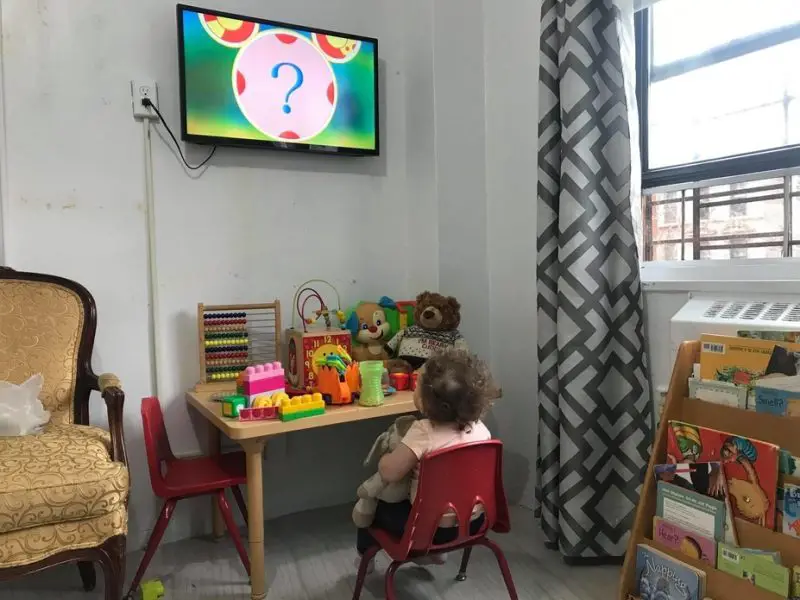So many of us would like our children to learn Spanish, and some parents wonder whether or not their children can learn it by watching TV. This has been on my mind too, as a soon-to-be parent interested in multilingualism (and as someone who studied language education in grad school!). Here’s what the research tells us:
Studies show that children cannot learn Spanish, or any language, simply by watching TV. Children can only achieve fluency in a language through “live” social interaction with other speakers. However, TV can be useful for children if used to learn Spanish in addition to meaningful social interaction.
Basically, we can’t just sit a child in front of Spanish TV for hours (nor would it be healthy to do so!) and expect that child to learn how to communicate fluently in Spanish. TV/screens should be seen as tool for learning a language, not as a teacher.
But you can watch some Spanish TV with your child and explain words and concepts to them – or Spanish TV can be used in addition to having interactions with other Spanish speakers (if you yourself don’t speak Spanish).

TV Isn’t Enough to Learn a Language
I’ve talked about this before on this website, that although there aren’t a TON of studies that have been done on this topic (there definitely need to be more!) — what we do know from certain cases is that kids simply can’t learn ALL there is about a language from TV alone.
Many scholars in language education now believe that social interaction is key to learning any language. We need to have human beings — parents, caretakers, siblings — responding to our attempts at new words and sentences, in real time.
Studies have shown that babies don’t learn language as well, or in some cases at all, from audio recordings and screens. They really do need that physical human interaction to be successful learners.
This idea is highlighted in a TED Talk by Professor Patricia Kuhl (you can find it at the 5:30 mark in the video). As she puts it, “It takes a human being.”
And we can all probably verify this from our own anecdotal experiences. Have you ever tried to learn a language without using it with other people? It doesn’t work!
As adults, we may be able to teach ourselves a LOT about another language with books and screens, but we won’t become fluent or proficient without using the language in a meaningful way with others. This is true for children as well.
And even if you wanted to teach your kids a language exclusively with television (or other devices), the amount of time they’d need to spend watching would be astronomical — something I also discuss in my other article here. Not ideal!
How to Use TV to Help Your Kids Learn Spanish
As I mentioned earlier, there are surprisingly so few studies on language learning and TV-viewing in children! What studies do seem to tell us is that social interaction (with real humans!) needs to be involved in learning Spanish or any language.
However, TV (and other devices) can be useful for learning vocabulary and other language skills, once children already have a foundation in that language — And especially when watching with an adult who can explain words and concepts to them.
You might have experienced this yourself as a child language learner, or as an adult watching TV with a child and explaining certain things to them (and repeating those things a lot!).
The American Academy for Pediatrics uses this recommendation for children aged 2-5 years: “Parents should co-view media with children to help them understand what they are seeing and apply it to the world around them.”
You can help your kids learn from educational TV programs. It’s just the way that you do it that matters.
Try to choose educational TV programs that:
- have a clear narrative (and not programs with lots of short vignettes that jump around a lot).
- have characters who speak directly to the children watching.
- have characters who ask children questions or to help with a task (mimicking real-life conversations).
This is based on a Linebarger and Walker (2005) study. You can read more about the kinds of TV programs that work best for learning vocabulary here.
TV Shows and Movies to Watch in Spanish With Your Kids
Some popular high-quality children’s programs that you may want to watch with your children include:
- Dora the Explorer
- Sesame Street
- Pocoyo
- Doc McStuffins
- Canticos
…Not to mention the many, MANY children’s shows and movies that you can set in Spanish on Netflix and other streaming platforms!
How to Choose Which Spanish Shows to Watch With Your Kids
When you’re looking for TV shows for your kids to watch to learn Spanish, you’ll have to ask yourself a few questions. Here are some things to think about:
- How old are your kids? Depending on your child’s age, you’ll want to decide how much TV is healthy for them to watch in the first place. The American Academy of Pediatrics currently recommends that children under 2 don’t watch TV at all and “For children ages 2 to 5 years, limit screen use to 1 hour per day of high-quality programs.”
- What is their Spanish level? If your children don’t yet speak a word of Spanish, you may want to choose programs that are in English but that “teach” Spanish vocabulary (think Dora the Explorer) and that serve to engage the child with direct questions. If your child is more advanced, you may want to let them watch educational programs such as Sesame Street in Spanish (with them if possible).
- What are your goals for your child? Think about what you’re trying to accomplish — Are you trying to reach fluency for your child? Do you want them to have a basic grasp of Spanish? Do you want them to be literate in Spanish? Conversational? Take a minute to really consider your goals and then choose a game plan that is doable (and that will be fun!). A game plan might be watching Sesame Street or a Disney movie in Spanish with your child for an hour a day, while you help them understand certain words and practice with them during and after watching.
- What is your own Spanish level, or the Spanish level of the adult who will be watching with your kids? Remember that children need an element of social interaction to be able to practice their language skills and really become good at it! So it’s important to consider who will offer that social element in addition to TV/movies. If it’s going to be you, do you need to practice your own Spanish at the same time? Great! You can learn right along with your child at home — you just need to be consistent and disciplined!
How to Teach Your Kids Spanish Without TV
There are alternatives to TV for learning Spanish (or any language!). Remember that TV/screens are simply a tool for helping your child (and you!) learn a language, but it shouldn’t be your teacher.
To teach your kids, and possibly yourself, another language without TV/screens, consider the following options:
Join a community center: Look for community or cultural centers in your area that offer activities in Spanish! You might be surprised at the number of cheap or free activities (sometimes even classes) that you can join. The best part is meeting other speakers of Spanish who your child can hopefully interact with in some capacity — or who can point you in the right direction toward useful resources!
Look for bilingual parenting groups in your area: Do some searching on social media (and do some Googling) for bilingual parenting groups. There may be play groups you can join with families who have similar goals to yours! Your child can meet other Spanish-speaking children, get motivated to learn Spanish, and practice language that’s meaningful and kid-friendly.
Read in Spanish with them: Even if you’re not fluent in Spanish, reading in Spanish with your children can be helpful for learning new vocabulary. You may find yourself (hopefully) learning faster yourself too, if Spanish-language learning is your goal as well!
Hire a bilingual babysitter or caretaker: If it’s a possibility for you to send your child to Spanish language daycare or to hire a Spanish-speaking babysitter, that could be an amazing opportunity for your kids to interact in Spanish in meaningful ways.
Good luck and happy language learning 🙂
SOURCES
If you’d like to learn more about this topic and get access to other language learning resources, you can find a full list of this website’s sources here.
